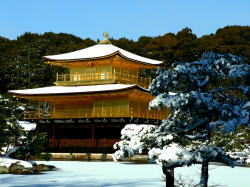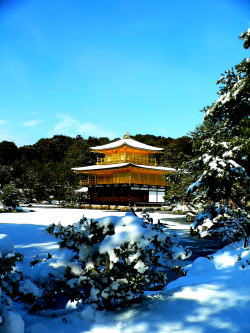金閣寺
Kinkakuji Temple


|
足利三代将軍義満によって建てられた豪華な建造物
A Gorgeous Architecture Built by Yoshimitsu, the 3rd Ashikaga shogun
鹿苑寺(ろくおんじ)
 アンタ、知ってた~?一般的には「金閣寺」って呼ばれてるけどさ、実は、正式な名前は「鹿苑寺」って言うのよ。なんでも仏舎利(ぶっしゃり)、つまりお釈迦さまのお骨をお祀(まつ)りしている舎利殿「金閣」が有名なため、そう呼ばれてるらしいわよ。アタシも死んだらクチバシでもお祀りしてもらおうかしらん。で、この「鹿苑寺」だけど、臨済宗相国寺(しょうこくじ)派の禅寺で、1994年に世界文化遺産に登録されたんだって。
アンタ、知ってた~?一般的には「金閣寺」って呼ばれてるけどさ、実は、正式な名前は「鹿苑寺」って言うのよ。なんでも仏舎利(ぶっしゃり)、つまりお釈迦さまのお骨をお祀(まつ)りしている舎利殿「金閣」が有名なため、そう呼ばれてるらしいわよ。アタシも死んだらクチバシでもお祀りしてもらおうかしらん。で、この「鹿苑寺」だけど、臨済宗相国寺(しょうこくじ)派の禅寺で、1994年に世界文化遺産に登録されたんだって。

PHOTO BY TARO MATSUKAZE
|
でさ、この場所にはもともと鎌倉時代に西園寺公経(さいおんじきんつね)って人の別荘「北山第」があったんだけど、足利三代将軍義満がとても気に入ってさ、応永4年(1396年)、西園寺家から譲り受け、山荘北山殿を造ったんだって。なんといってもすごいのがここの庭。金閣を中心とした庭園・建築は極楽浄土をこの世に現わしたと言われてるのよ。いいわね~、極楽浄土。やっぱり、死んでから行くなら地獄より極楽よ、アンタ、どっちがいい?
でもって、この北山殿に後小松天皇を招いたり、中国(明の時代ね)からのお客さんを接待したり、飲めや歌えの宴会続きだったかは別にして、迎賓館みたいな使い方をされてたみたいよ。いいわよね~、アタシも招待して欲しいわよん。それでさ、明との貿易で得た収益をつぎ込んで、こういった金閣寺みたいな豪華な建物を建てたりしたのよね。やっぱり、お金がないと豪華な文化は育たないし、そういう意味では、明との貿易が文化の発展に貢献したってことね。ということで、この時代の文化を特に北山文化って言うらしいわ。ところでさ、アンタ、後小松天皇っていう人は、あの有名な「一休さん」のお父さんなんだって。
で、いつごろ「鹿苑寺」って名前がつけられたかっていうと、足利義満の死後、その遺言に従って、夢窓国師(むそうこくし)ってお坊さんを開山(初代の住職)にして、義満の法名の「鹿苑院殿」から二字をとって、鹿苑寺と名づけられたんだって。
Rokuonji Temple
Popularly-called Kinkaku-ji (Golden Pavilion) for its famous golden stupa: a monument honoring Buddha's relics, its official name is Rokuon-ji Temple. The temple belongs to the Shokoku-ji school of the Rinzai Buddhist denomination. It was listed as a World Cultural Heritage site in 1994.

PHOTO BY TARO MATSUKAZE
|
Once there was a villa of Saionji Kintsune, a political figure in the Kamakura Period (1192 - 1333) at this location. Yoshimitsu, the third shogun of the Ashikaga reign took the liking of this site and obtained it from the Saionji in 1396. Yoshimitsu built Kitayama Palace, on the grounds centered around the golden stupa (Kinkaku). The entire palace premises consisting of the Golden Pavilion, garden and architectures represents an after-world Buddhist paradise.
Kitayama Palace used to stage both political and cultural centers in the age. It was a guest house for Emperor Gokomatsu, who frequently visited Yoshimitsu, as well as for delegations from China (Ming). The profits obtained from the trades with Ming had financed the construction of the palace, which leads to blooming of the contemporary culture dubbed as Kitayama style.
After Yoshimitsu's death, Master Musōkokushi (the first chief abbot of the temple) founded Rokuonji temple following Yoshimitsu's will. The name Rokuonji was coined from posthumous name of the shogun.



 アンタ、知ってた~?一般的には「金閣寺」って呼ばれてるけどさ、実は、正式な名前は「鹿苑寺」って言うのよ。なんでも仏舎利(ぶっしゃり)、つまりお釈迦さまのお骨をお祀(まつ)りしている舎利殿「金閣」が有名なため、そう呼ばれてるらしいわよ。アタシも死んだらクチバシでもお祀りしてもらおうかしらん。で、この「鹿苑寺」だけど、臨済宗相国寺(しょうこくじ)派の禅寺で、1994年に世界文化遺産に登録されたんだって。
アンタ、知ってた~?一般的には「金閣寺」って呼ばれてるけどさ、実は、正式な名前は「鹿苑寺」って言うのよ。なんでも仏舎利(ぶっしゃり)、つまりお釈迦さまのお骨をお祀(まつ)りしている舎利殿「金閣」が有名なため、そう呼ばれてるらしいわよ。アタシも死んだらクチバシでもお祀りしてもらおうかしらん。で、この「鹿苑寺」だけど、臨済宗相国寺(しょうこくじ)派の禅寺で、1994年に世界文化遺産に登録されたんだって。

